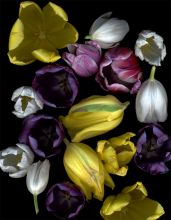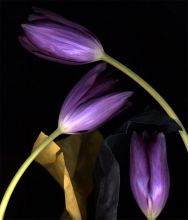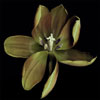











To arrive at the edge of the world's knowledge, seek out the most complex and sophisticated minds, put them in a room together, and have them ask each other the questions they are asking themselves.
 |
 |
 |
 |
 |
 |
 |
 |
 |
 |
 |
 |
[Click on Images to Enlarge]
Introduction by Kevin Kelly
I have mounted on my wall a most remarkable image. It's a gloriously vibrant water lily, with creamy colors and almost infinite deepness in detail and tone. It's large, about two feet square. It was neither painted, nor is it technically a photograph. It's beautiful. Everyone who has seen it has remarked on how stunning it looks, and how unlike a typical photograph. It looks like a painting but it is much to finely tuned and rendered, too polished. It's different.
This flower is one of a series of ravishing images made by Katinka Matson; the images in both her series, Forty Flowers (January, 2002) , and the current Twelve Flowers, can be seen here on Edge in low resolution versions. Katinka Matson's digital images are both pioneering and representative. She is in the venerable mode of following the technology.
Painting, the technology, changed how we use our eyes. Photography, another technology, changed how we painted. According to painter David Hockney's controversial theory, early experiments with optics and drawing "put a hand in the camera." Painters like Vermeer traced images from convex mirrors and simple lenses—thus the hand in the camera. Now the newest technology, digital gear, is overhauling photography, in part by putting the hand back into the camera. That's what we call Photoshop. Whatever distinction there may have been between painting and photography, Photoshop has completely vanished it. We can put our fingers into photographs, or mechanicize hand-crafted paintings. However this vanishing act required not only Photoshop, but two other technologies: a digital retina, and ink jet printing.
There are many ways to make an artificial eye. We assume a central lens is needed because that's how our eyes work and cameras, too. That's why it is a shock to hear that Matson's images weren't made with a camera. How else could it be done? In 1975 Ray Kurzweil explored a different route by inventing a flat bed scanner. The eye became a sensitive stick that floated along the object to be seen. When the object was a flat piece of paper this was easy. A room, or the world outside, however was too distant for the sensitivity of the scanning eye without a lens, so in our minds we kept the scanner enslaved to papers and books.
Like the many people who xeroxed their body parts for fun, or used a copy machine for art, Matson discovered that the scanning eye stick was far better at depth that was assumed. More importantly as color scanning became cheap, and then became super hi-res, the final image of a quick scan had all the detail of a painting. She began composing cut flowers on a scanner bed and capturing the color images. So the images you see here were not photographed but scanned with an ordinary office scanner. The grace of the images is self-evident. But there was one more needed technology to bring them to life: ink jet printing.
Scale is an important aspect of the visual world. Paintings could be made larger than photographs because of the constraint the falloff of light had on the physics of photographic printing. It was difficult (expensive) to keep the tones on a wall-size photographic print even from the center to the edges because of the differential in distance from the projecting lens. It was difficult (expensive) to chemically treat paper in the dark evenly at this scale. It was difficult (expensive) to maintain temperature (which affected color) at this scale. It was difficult (expensive) to capture sufficient resolution at this scale. Therefore photographs were created smallish. All these constraints have been removed by digital photography and ink jet printing.
It is now possible to make a very, very large ink jet print that has more resolution that your eye can discern, that has as much color as oil paint (and as permanent), that is critically even from edge to edge, and that is reproducible in however many quantities you need. I recently finished a book of color photographs published by the world's best art house publisher, printed in the best printer in Italy, and the colors of these pages can't compare to the ink jet prints that I made of the images as a proof. And this technology will only get better.
When I saw Matson's images I was blown away. Erase from your mind any notion of pixels or any grainy artifact of previous digitalization gear. Instead imagine a painter who could, like Vermeer, capture the quality of light that a camera can, but with the color of paints. That is what a scanner gives you. Now imagine a gifted artist like Matson exploring what the world looks like when it can only see two inches in front of its eye, but with infinite detail! In her flowers one can see every microscopic dew drop, leaf vein, and particle of pollen—in satisfying rich pigmented color.
Matson has a gift with design. I delight in her new images, particularly the sly one with a wood mushroom and flower. She is at the forefront of a new wave in photography, or what we should call new imaging. New cameras, like the Foveon, new scanning technology, and new pigmented printers like the Epson series, are all going to give artists like Matson room to reinvent how we see again.
Kevin Kelly
February 2002
Kevin Kelly helped launch WiredMagazine in 1993 and served as Executive Editor. In 1994 and 1997, during Kelly's tenure, Wired won the National Magazine Award for General Excellence.











